In the spring of 1904, a major Ruskin Exhibition was mounted at the Manchester City Art Gallery. It presented drawings and paintings by Ruskin, Turner and the Pre-Raphaelites, pictures of architecture and copies by Ruskin’s pupils, as well as portraits and manuscripts. The speeches made at the official opening, and an accompanying series of public lectures, indicate the nature and extent of Ruskin’s influence at the time both in Manchester and further afield.
THE EXHIBITION
The exhibition, which ran from 22 March to 14 May, consisted of 431 drawings and paintings, plus 105 other items including manuscripts, blocks, autograph letters and books, displayed in a suite of four rooms at Manchester City Art Gallery.
The first room showed 115 drawings, most of them by Ruskin himself. The first group focussed on Ruskin’s “Student Days” and showed 60 of his drawings executed between the ages of 10 and 21. The next 22 exhibits illustrated the relationship between Ruskin’s still-life drawing of plant-forms and so on, with the work of his friend, William Holman Hunt (1827—1910). The next group consisted of 24 drawings by Ruskin from the Cunliffe Collection, a series assembled by the successful Lancastrian solicitor Robert Ellis Cunliffe (1848-1902), all hung together by the ledner’s request. The room was completed with another 11 drawings.
The second room comprised 102 drawings and paintings. The first group presented 19 examples of the work of ancient and modern artists chosen to illustrate key principles and passages in Ruskin’s writings. Then came 51 examples of Turner and of Ruskin’s studies of Turner’s works, followed by 20 examples of works by the English Pre-Raphaelites, and 12 copies of Old Masters praised by Ruskin.
Room III, with 105 exhibits, focussed on the period from the early 1840s to 1860 when Ruskin wrote the five volumes of Modern Painters, The Seven Lamps of Architecture, and The Stones of Venice.
Room IV explored the theme of “Ruskin as Teacher”, and was chiefly composed of the later drawings from Ruskin’s time as Slade Professor of Fine Art at Oxford, with 109 works by artists Ruskin recommended to his students, and of pupils he taught. The exhibition also included 17 Ruskin manuscripts and books, 22 annuals and other publications to which Ruskin had contributed, 17 early editions of his books, and six autograph letters. A further assortment of Ruskiniana, comprising 49 Ruskin books, blocks and other items rounded off the display.
Among that later medley was a presentation copy of Samuel Rogers’s Italy, a poem—the book whose exquisite engravings caused Ruskin to fall in love with the artwork of Turner. It boasted Rogers’s autograph inscription, “To John Ruskin, Esq., with the sincere regard of the author” while on another leaf was written “The second of two copies given by the author to me with his autograph. Given by me, with kind regards, to Arthur Burgess, 1869. J. Ruskin.” Arthur Burgess (1843—1886) was one of Ruskin’s band of copyists whose work was shown at Ruskin’s museum in Sheffield. Born in Gloucester, the son of a glue maker and chemist, Burgess grew up in Peckham and was apprenticed as a wood engraver. Ruskin’s affectionate tribute, written on Burgess’s death, and published in Hobby Horse, the journal of the Century Guild, testifies to Ruskin’s admiration and respect for him. (Burgess’s mother was a member of the Quaker Rowntree family of Yorkshire.)
Another notable item in the exhibition was a first volume of Modern Painters (5th end) presented by Ruskin in 1855 to Dante Gabriel Rossetti (1828—1882) when Rossetti assisted him in teaching drawing at the London Working Men’s College. Ruskin inscribed the book “with sincere and respectful regards”.
You can read about some of the pictures exhibited in Manchester elsewhere on the web:
“Trinity College Chapel, Edinburgh” (1838) by John Ruskin.
“Study for The Sun of Venice Going to Sea” by J.M.W. Turner (1843).
“Spanish Chestnuts at Carrara, Italy” (1856-57) by John Ruskin.
The exhibition was open daily from 10am to 8pm, and from 2.30pm to 5pm on Sundays. Entry cost sixpence on Tuesdays and Fridays, but was otherwise free. The Manchester Guardian reported at the end of the run that:
“Judged by the attendance, it has been the most successful art exhibition held in Manchester for many years past. The turnstile records show that 76,100 visits have been paid to the rooms set apart for the exhibition […]” (16 May 1904).
A 158-page Catalogue, prepared by W. G. Collingwood, was published by the Art Gallery. According to the Manchester Guardian, 7000 copies of the Catalogue, which cost sixpence, had been sold by the end of the show (16 May 1904).
THE OFFICIAL OPENING
On 24 March, the Manchester Guardian published a detailed report of the exhibition’s official opening. The account of the words uttered by Manchester’s Worthies is particularly interesting.
“There was a gathering of Manchester men and women representative of all that makes for progress and good order, and a personal touch was given by the presence of Mrs [Joan] Severn [(1846-1924)], Ruskin’s adopted daughter. The Exhibition is under the care of the Art Gallery Committee of Manchester Corporation.”
The paper explained that William Gershom Collingwood (1854—1932), “who was at one time private secretary to Mr Ruskin”, and John Ernest Phythian (1858—1935) “have taken the principal parts of the work in bringing so much of Ruskin to Manchester”. Phythian was among the most important of Manchester’s Ruskinians. He was a founding member of the Ruskin Society of Manchester, he became a Companion of Ruskin’s Guild of St George, and in his art committee work and frequent popular lectures he promoted Ruskinian ideas and values. My next blog post will attempt to remedy the absence of a considered biographical sketch of this crucially significant figure. His pivotal role as co-organiser of the 1904 Exhibition deserves to be remembered in the account that follows.
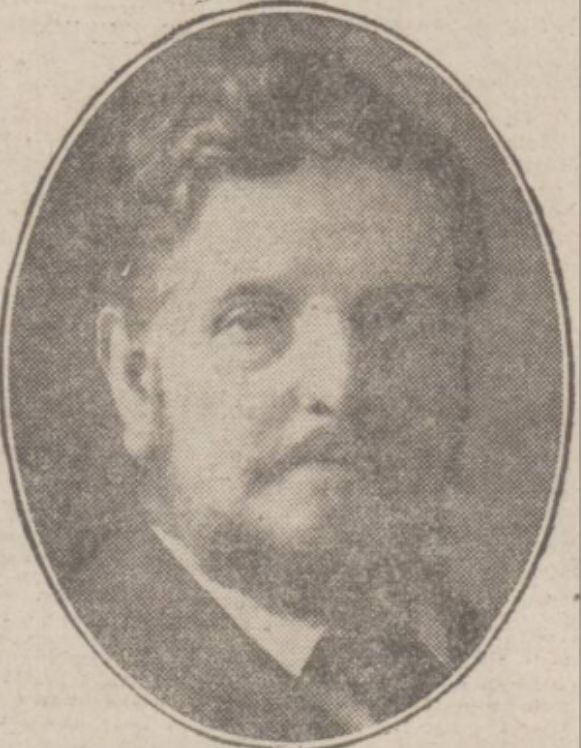 The formal opening of the Exhibition was preceded by a luncheon at the Town Hall. Presiding was the Lord Mayor, Sir Thomas Thornhill Shann (1846—1923) [pictured], a businessman and public servant who strongly supported educational work in the city.
The formal opening of the Exhibition was preceded by a luncheon at the Town Hall. Presiding was the Lord Mayor, Sir Thomas Thornhill Shann (1846—1923) [pictured], a businessman and public servant who strongly supported educational work in the city.
Among the gathering, but with no official role in proceedings, were members of the Art Gallery Committee; the Catholic Bishop of Salford Dr Louis Casartelli (1852—1925); Sir Frank Forbes Adam (1846—1926), President of the Bank of Bombay, and then President of the Chamber of Commerce; Manchester’s Deputy Mayor, Sir James Hoy (1837-1908); the Rev. Canon Edward Hicks (1843-1919), Canon Residentiary of Manchester Cathedral and later Bishop of Lincoln; the engineer and Liberal politician, William Crossley (1844-1911); the yarn merchant and Liberal politician Arthur Haworth (1865-1944); the cotton manufacturer and Ruskinian philanthropist Thomas Coglan Horsfall (1843—1932 ; and Horsfall’s friend, the grey cloth merchant and public servant George Milner (1929—1914), who was the first chairman of the Council of Horsfall’s Art Museum in Ancoats and treasurer of Manchester University Settlement.
It fell to Alderman Joseph Thompson (1833—1909), Chairman of the Art Gallery Committee, to get official proceedings under way by proposing the toast to “The Memory of John Ruskin”. He contrasted
“the Manchester of to-day in the matters of painting, music, and higher education with what it was fifty years ago, and expressed his conviction that Ruskin’s influence had been a potent factor in bringing about such a great change for the better. Fifty years ago these three things were in a very low condition, but just as we at this time felt that spring was in the air and that very soon it would bring to us blossom and flower, so in those days there were the signs of a renaissance in art. There were good men and true who banded themselves together and determined to do what they could to raise Manchester out of the position which the world had appointed for her, and the result of that determination was seen in the glorious [Art Treasures] Exhibition of 1857. At that Exhibition there was a daily performance of music under the leadership of a young man who had recently come to Manchester who was named Charles Hallé. The success of those musical performances led to Mr Hallé’s stay in Manchester and to the establishment of those Hallé Concerts which has done so much to elevate the taste of music in this city. Music, painting, and education had improved. What was the cause? There had been many causes, but he did not hesitate to say that he whose memory they held in reverence that day was largely accountable for the change. Ruskin’s influence was felt in Manchester as it was throughout England.”
On the matter of Manchester’s Ruskin Exhibition, Thompson said
“We owed this Exhibition to the munificence of many friends, and very largely indeed to Ruskin’s friend and biographer, Mr Collingwood, and to Mr [J.] Ernest Phythian, one of the members of the Art Gallery Committee. The Ruskin Exhibition would show very distinctly how well [Ruskin] observed his own dicta—that ‘the only rule without exception respecting art is that “all great art is delicate”; that “the sight is a more important thing than the drawing”, and that he would rather teach drawing that his pupils “may learn to love nature than teach the looking at nature that they may learn to draw”.’ That, said Mr Thompson, was the great value of Ruskin to us, that he had taught us to look at nature as we perhaps never looked on it before, and to see in shade and sunshine, in cloud and landscapes, in sea, sky, and land all the wonderful beauties which nature was constantly unfolding before our eyes.”
Sir William Stephens, the Mayor of Salford, who toasted “The Lord Mayor and Corporation”, addressed the matter of Ruskin’s history of antagonism towards Manchester, and said he thought
“Ruskin proved himself to be but mortal in misunderstanding Manchester. Ruskin never thought that Manchester would have held an exhibition in his honour. It was clear that we were living in better times than those which were no more admired by our fossil friends. As to the toast he was proud of the Manchester Corporation as of its distinguished head. ‘I am a Manchester man myself’, Mr Stephens added, and there was much cheering in approval of the declaration. Like many other Manchester men, he made his money in the city and lodged outside.”
Sir Thomas Shann, the Lord Mayor of Manchester, said that what was interesting to the city was interesting to Salford.
“When Manchester suffered, so did Salford, and vice versa, and the sooner that little river which divided the two places was covered over and became a boulevard on which people could stroll about the better.”
The audience cheered.The Lord Mayor and his wife, the Town Clerk, Joan Severn, and members of the Art Gallery Committee processioned to the City Art Gallery and a new round of speeches began.
“At the end of the room where the Ruskin pictures are displayed there was a platform. Mr Alderman Thompson took the chair, and called upon the Town Clerk to read an account of the characters and objects of the Exhibition. This, among other things, reminded those who heard it of ‘some of the associations of John Ruskin with Manchester’.
“In connection with the Art Treasures Exhibition of 1857 [Ruskin] delivered the two lectures on The Political Economy of Art, and on the same occasion he gave the boys of our Grammar School an address. On February 22, 1859, at the annual meeting of the Manchester School of Art he delivered the lecture entitled ‘The Unity of Art’. Two of his most delightful lectures – ‘[Of] Kings’ Treasuries’ and ‘[Of] Queens’ Gardens’, published in Sesame and Lilies, were delivered in the Rusholme Public Hall in 1864.”
The Town Clerk added that when the Rusholme Branch Library was officially opened in 1892, George Anson (1820—1898), the Archdeacon of Manchester in the 1870s and 1880s, said that when, as the Rector of St James’s Birch-in-Rusholme, he had requested Ruskin to deliver the 1864 lectures at Rusholme
“Ruskin asked what he was to lecture upon, and in reply to the suggestion that he should deal with ‘his own subject’ he said ‘No, I wanted to talk about books and the value of libraries’. On being invited to give a title for the lectures Ruskin said ‘No, you must select the title yourself’. Archdeacon Anson suggested ‘What and How to Read’, or something equally prosaic, and Ruskin said that would do, but he afterwards sent his own titles ‘[Of] Kings’ Treasuries’ and ‘[Of] Queen’s Gardens’.”
The Town Clerk pointed out that Ruskin’s letters to Thomas Dixon (1831—1880), the working cork cutter from Sunderland, published as Time and Tide by Weare and Tyne (1867), first appeared simultaneously in the Manchester Examiner and Times and the Leeds Mercury. It was also in Manchester that the original Ruskin Society first met in 1879 and Ruskin’s letter to the secretary of the Society was read out. In it Ruskin suggested that the Society’s aim should be “to promote such English learning and life as could abide where the wild rose grews”. The letter formed part of the Exhibition.
Thomas Shann, the Lord Mayor, before declaring the Exhibition open, said the occasion
“was one of special interest to all who believed in the spread of a knowledge of true art and a love of honest work. It was a matter for congratulation that they had there in the City Art Gallery been enabled to gather together so many examples of Ruskin’s long and laborious life. He thought that Manchester which had always been the friend of art, in doing honour to Ruskin was conferring true honour upon itself.”
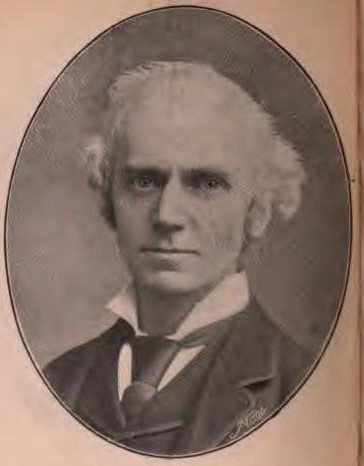 Some speakers neither shied away from nor glossed over Ruskin’s often fierce attitude to their city. The politically engaged lawyer and academic Dr Alfred Hopkinson (1851—1933) [pictured], who was the Vice Chancellor of Manchester University, thought it peculiarly fitting that Manchester should “take an active part in a demonstration in honour of the memory of one of the greatest teachers England had produced”, for it was in Manchester, he said, that
Some speakers neither shied away from nor glossed over Ruskin’s often fierce attitude to their city. The politically engaged lawyer and academic Dr Alfred Hopkinson (1851—1933) [pictured], who was the Vice Chancellor of Manchester University, thought it peculiarly fitting that Manchester should “take an active part in a demonstration in honour of the memory of one of the greatest teachers England had produced”, for it was in Manchester, he said, that
“some of the most characteristic teachings of Ruskin were first heard. In many of Ruskin’s writings and spoken words there were a few home truths told in regard to Manchester to which we did well to give heed.”
Hopkinson went on to say that Ruskin had taught them “to have a high ideal”: “the right to rule was determined by the willingness and the capacity to serve”. He contested the frequent criticism levelled at Ruskin that he was “unpractical” and
“on examination he believed it would be found that [Ruskin’s] views were the really practical ones, the ones that would be really fruitful for good if they were only more generally accepted”.
Hopkinson said that he had readily agreed to take part in the opening of the exhibition because
“it seemed appropriate that the representative of our University should do what was possible to give expression to the sympathy which those who took part in higher education must feel for such an effort as this exhibition to make better known to our citizens and to excite more interest in the work of a great teacher, and partly because from the time when he had the privilege of hearing Ruskin’s famous lectures on art at Oxford he had felt, and still felt with undiminished intensity, the immense value of the influence of Ruskin’s work.”
Hopkinson was a student at Lincoln College, Oxford, from 1869 to 1873, and in 1875 he was appointed joint professor of jurisprudence and law at the Victoria University, Manchester. He admitted that others might
“speak with fuller knowledge of [Ruskin’s] influence on art, of the light which Ruskin shed on architecture, on painting, on the beauty in nature and in the best work of man, which we had learned to see more clearly under his guidance, but what he wished specially to speak of was [Ruskin’s] political teaching—using the word in its best sense,—which had become a growing influence in our national life, and the power of essential rightness, of which he had the reason to become more and more convinced. Thirty years had passed since Ruskin gave those Oxford lectures, but in them he revealed a way of looking at political questions, at the questions which affected our national life, which had had an effect both great and beneficial upon our people. To Ruskin we owed an enormous debt for his social, political and moral teaching. It was the same teaching in effect though worked out in greater detail and from a more practical point of view, that we found in the writings of Burke and the poetry of Wordsworth. He therefore said to everybody who cared about his country or took any part in political life, ‘Read and absorb the whole of Ruskin’. Do not attempt to apply every detail of his teaching in the exact way he may have given it, but absorb the spirit of it. Study the guiding principles of it. Form your ideal, and when that ideal is before you let it be a high one, and let it be a fixed and clever one.”
Joan Severn [pictured with Ruskin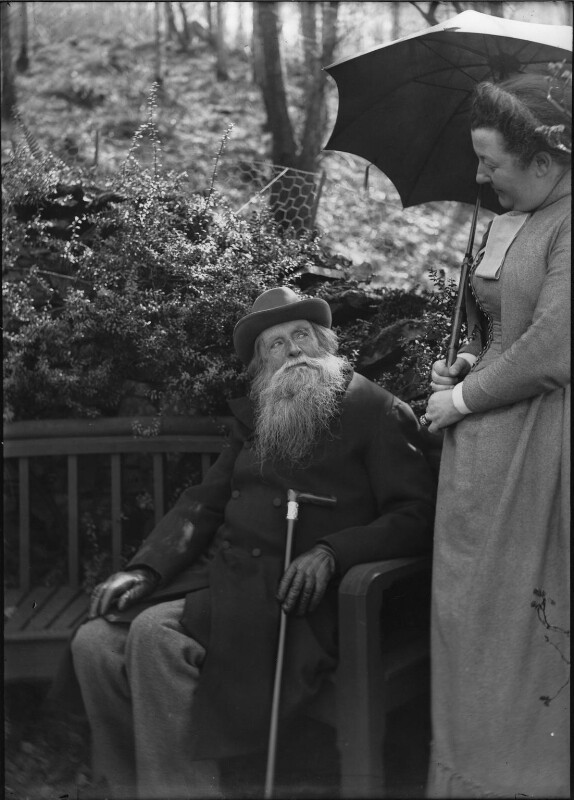 ] then rose to speak and was given “a cordial reception”. Usually deferring at public events to her husband, the artist [Joseph] Arthur Severn (1842—1931), she told those assembled that she deeply regretted his absence in Italy. This seems to have been one of the rare occasions that Joan Severn addressed an audience herself, so her words are worth giving as they were presented in Manchester Guardian.
] then rose to speak and was given “a cordial reception”. Usually deferring at public events to her husband, the artist [Joseph] Arthur Severn (1842—1931), she told those assembled that she deeply regretted his absence in Italy. This seems to have been one of the rare occasions that Joan Severn addressed an audience herself, so her words are worth giving as they were presented in Manchester Guardian.
“I have been asked to say a few words, but it would take many to express the pleasure and pride I feel in being here today. One has often heard that when Manchester does a thing it does it well, but it has surely surpassed itself in the wonderful way this Exhibition has been made to work not only by my distinguished kinsman but of other artists bearing upon it, whose work he loved and was interested in. The Corporation and the Art Gallery Committee may well be congratulated on having got such indefatigable helpers as Mr Phythian and Mr Collingwood. It has a special interest for me, being here to-day, because when I first made the Master’s acquaintance (as an adopted daughter of his, and his mother’s, in the old Denmark Hill days) he was then at work on his two famous lectures Sesame and Lilies for Manchester , little thinking then that Lancashire would become his home, where some of his happiest, if yet some of his saddest, years were to be spent; and may I add that some of the saddest had a brightness lent to them in which your most distinguished art collector lent a part. And, though no relation of his, I felt proud at the time that my maiden name had been Agnew. It was in purchasing the famous [Pass of thef] Splügen [(1842)]—a Turner [watercolour] that Ruskin had always coveted and offered carte blanche for it if ever it came into the market. And when he was ill, kind and generous friends, hearing that it was to be sold at Christie’s [in 1878], subscribed £1,000 to buy it for him. Mr Agnew gave a ‘bid’ beyond this, but when told the story he generously withdrew, though prepared to give anything, and added to the courtesy by contributing his own extra ‘bid’ as a subscription to the gift. It was a pathetic moment for me, having to present that picture, alone, to the beloved Master, when he had sufficiently recovered from that sad illness. He was quietly sitting in his armchair in the Brantwood drawing-room, with light on the left. I stood it on a chair in front of him. He leant forward eagerly, saying, ‘What a marvellous copy. I could almost believe it to be the original did I not know it was impossible.’ I said, ‘It is the original and it is yours’, and then I told the story of its gift. It has been since hung, as it is now, in a central place over his bed, where to the last it gave him joy.”
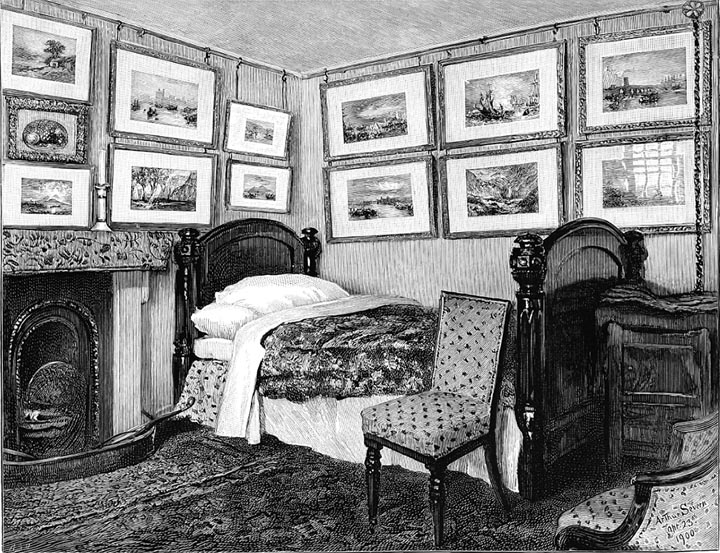
Arthur Severn’s picture of Ruskin’s bedroom, showing the Turner watercolours in situ, was on show at the exhibition, and “even in the miniature sketch” it was “quite recognisable”, Joan said.
“I fear I may be trespassing too long on your time, but it is all the Lady Mayoress’s fault, and you must blame her if I tell you a little story showing the Master’s love for and sympathy with children. I once went into his study and found him with my youngest son, Herbert [Sedgwick Seven (1882-1935)], then about four or five, both with their heads well down, and the child eagerly was saying ‘Oh Deepie’ (the children’s name for him) ‘do put more smoke coming out of the engine’: and the Master looked up at me with an amused appealing look that said, ‘See what I am reduced to’? He had been drawing, very badly, I fear, a railway train, and was on the point of giving a fine curl off of the smoke from the funnel. That boy has for the last two years been following his child’s love of engines in Messrs. Mather and Platt’s works [in Newton Heath], and I am very pleased that he got a day off and is here now not only in person but as an exhibitor of his own Ruskin drawings.”
[M. & P. Engineering is still processing and packaging food today (2020).]
J. Ernest Phythian then read aloud a number of letters that had been received from eminent men who were unable to attend the exhibition opening. Among them were William Holman Hunt, who “regretted his inability to be present in person”, and said he was
“glad to have some of his pictures associated with those of other artists who worked to bring about the reform of art (which, quite independently of each other, Ruskin and the Pre-Raphaelites devoted themselves to achieve). Mr Holman Hunt added that he had the honour of knowing Manchester first in the year 1857, the year of the glorious Loan Exhibition. This placed Manchester in a position which made all artists look to her as setting a fine example to the art taste of the country, an example repeated in the year of the [Golden] Jubilee [of Queen Victoria, in 1887], when again she brought together a superb collection of works of art, rarely if ever equalled in England.”
The artist, illustrator and socialist Walter Crane (1845—1915) had written:
“In the midst of the din and smoke of the machinery for the increased production of material gain, amid the fierce industrial fight which he saw obscuring the beauty of the earth he loved so well, Ruskin never for a moment lost sight of the truth that, after all, there is no wealth but life—life in its higher and fuller sense, and that our accumulations of material wealth are of little use unless the conditions of a fair and full human life, however simple, are secured to every member of the community who will work honestly for the common good.”
Sir Oliver Lodge (1851—1940), the Vice Chancellor of Birmingham University, wrote that the
“analytical power and influence of Ruskin’s social teachings have not yet reached their zenith, so it seems to me, and I fully expect that he will be still more highly revered by coming generations, when trivialities and accidental mannerisms shall have been forgotten”.
Frederic Harrison (1831—1923), the positivist and historian whose study of Ruskin appeared in 1902, wrote:
“John Ruskin was not only a genius who shed lustre on the Victorian era, but his subtle and pure enthusiasm permeated the entire moral, social and aesthetic atmosphere of his generation.”
Appreciative letters were also received from the historian and Liberal politician James Bryce (1838—1922), the artist, designer and sculptor Sir William Blake Richmond (1842—1922), the politician and sportsman Alfred Lyttelton (1857—1913), and the artist George Frederick Watts (1817—1904) who died little more than three months later. A letter from William Michael Rossetti (1829—1919) written on 25 March to Charles Rowley and addressing Ruskin’s influence on the Pre-Raphaelites appeared in the Manchester Guardian on 29 March.
“In the evening”, the Manchester Guardian concluded, “there was a soirée at the Art Gallery”.
PUBLIC LECTURES
The exhibition spawned a series of six popular public lectures. Some of these were free to attend, others cost sixpence, though season tickets were also available. The calibre of the lecturers is remarkable, and a full account of each lecture, though it falls outside the scope of this blog, would make for fascinating reading.
The first lecture was given by J. Ernest Phythian, the co-organiser of the exhibition and someone whose life we’ll look at in my next blog. His lecture, entitled “All true art is praise”, was delivered at the Mayor’s Parlour in the Town Hall on 29 March. All the other lectures took place in the Large Room at the Town Hall.
Easter falling on 3 April, it was a fortnight before the second lecture took place (11 April). The speaker was John Lewis Paton (1863—1946), High Master of Manchester Grammar School, who spoke on “Ruskin and the Schools”. The remaining lectures took place at weekly intervals. The third speaker was John William Graham (1859—1932), a university mathematics lecturer who served as the Principal of Dalton Hall, Manchester, from 1897 to 1924. A Companion and later a trustee of Ruskin’s Guild of St George, his dedication to Ruskinian ideals would lead him to write The Harvest of Ruskin which was published in 1920. His subject on 19 April was “Ruskin’s Reconstruction of Society”.
On 26 April, the Very Rev. George Kitchin (1827—1912), Dean of Durham, spoke on “The Economic Grounds of Ruskin’s Teaching”. His book, Ruskin in Oxford, and Other Studies had appeared the previous year (1903). The fifth lecture, on “Ruskin and Architecture”, was given on 3 May by the arts-and-crafts architect Prof. Stewart Henbest Capper (1859-1925). The session was chaired by another Ruskinian architect Thomas Worthington (1826—1909), whose Gothic Revival buildings remain a striking feature of Manchester and its surroundings. Capper worked closely with another Ruskinian, the sociologist and town planner, Sir Patrick Geddes.
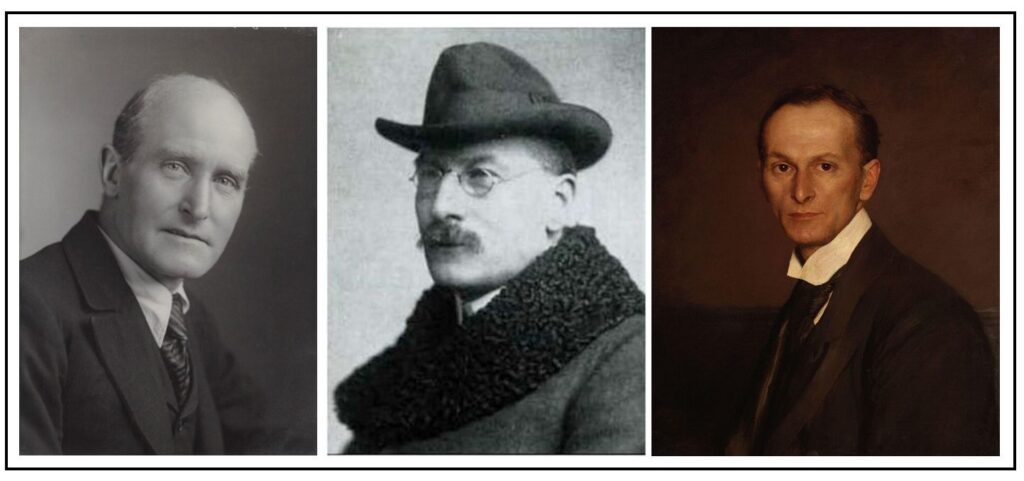
Paton, Capper and Spielmann
The last of the lectures was given on 10 May by the art critic Marion Spielmann (1858—1948), editor of the Magazine of Art from 1887 to 1904. His book, John Ruskin: A Sketch of His Life, His Work, and His Opinions, with Personal Reminiscences had been published in 1900. The report of Spielmann’s lecture was republished by The Guardian in 2017 (note the mistaken reference to Proust instead of Samuel Prout). The report states that the geologist and archaeologist Professor Boyd Dawkins (1837—1929) seconded Phythian in proposing a vote of thanks to Spielmann. Dawkins, a former curator of the Manchester Museum, and the first Professor of Geology at Owens College, was then President of Manchester Literary and Philosophical Society (1903-1905). The Manchester Guardian report notes that Dawkins was “warmly applauded when he declared that the Ruskin Exhibition had rendered life in Manchester richer than before, and expressed a hope that in the future a series of exhibitions on similar lines might be provided”.
Manchester’s Ruskin Exhibition in the spring of 1904 remains one of the most impressive and ambitious attempts ever made to present Ruskin to the public, and it provides significant evidence of the state of Ruskin’s reputation at the start of the twentieth century